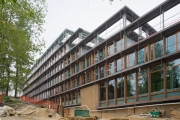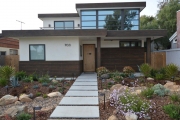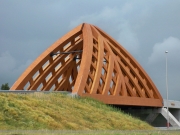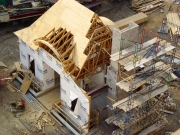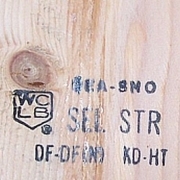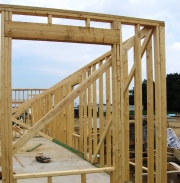
06 11 00 Wood Framing
Accoya Modified Wood Helps Green Home Project In Bid To Achieve Platinum LEED Certification
Advanced Framing Techniques
In today’s construction world, where green is the future, it pays to know about building techniques that not only count toward a green building rating but can actually reduce up-front costs. One such method is known as Advanced Framing, sometimes called Optimum Value Engineering (OVE). Advanced Framing takes a good hard look at the way we frame buildings and tries to eliminate wood whenever possible without compromising structural integrity. All of these techniques, when properly executed, comply with the International Residential Code (IRC), but you should check local codes before beginning a project.
Green Building Products: Accoya Wood
Builders looking for a sustainable, environmentally friendly product may want to consider Accoya® wood, which matches or exceeds the durability and stability of the very best tropical hardwoods. Accoya, made from fast-growing softwoods, was introduced to the North American market in 2008. The process used to make Accoya is called acetylation, which has been studied for over 80 years. Accsys Technologies, the makers of Accoya wood, built its production facility in 2007.
Basics of Wood Framing
Wood framing, or light frame construction, is the assembly of dimensional lumber or engineered wood lumber that is regularly spaced and fastened together with nails to create floor, wall and roof assemblies. Wood is the most common material used within the construction industry today.
Mechanically Graded Lumber
Mechanically graded lumber is lumber that has been tested and evaluated by a machine rather than by visual inspection. While most lumber is visually inspected and graded, machine grading is a more efficient volume service and creates cost-competitive products, while differentiating the higher strength lumber materials. It is commonly used to deliver materials for more demanding applications. Two types of machines are used to grade lumber, machine-stress rated (MSR) lumber and machine evaluated lumber (MEL) machines.
Engineered Wood Products
Engineered wood materials are manufactured products that utilize strands, particles, fibers, and veneers of wood to produce a range of different types of products. Readily available at lumber yards, these products are cut to length in the field, similar to dimensional lumber. The application of engineered wood products is also similar to that of dimensional lumber; however, each offers its own performance and manufacturing advantages. Engineered wood products also have some disadvantages in comparison to dimensional lumber. They have less fire resistant, require more energy to manufacture, have adhesives that can potentially release toxins into the environment, and are prone to moisture damage. Engineered wood products are often used as columns, beams, girders, joists, purlins, rafters, studs and bracing.
Wood Framing
Wood framing, or light frame construction, is the assembly of dimensional lumber or engineered wood lumber that is regularly spaced and fastened together with nails to create floor, wall and roof assemblies. Wood is the most common material used within the construction industry today.
